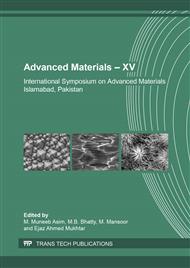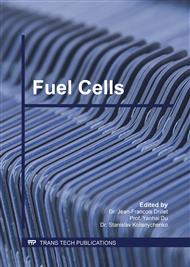[1]
F. Barbir, T. Gomez, Efficiency and economics of proton exchange membrane (PEM) fuel cells, Int. J. Hydr. Ener., 22 (1996) 1027-1037.
DOI: 10.1016/s0360-3199(96)00175-9
Google Scholar
[2]
J.H. Wee, Applications of proton exchange membrane fuel cell systems, Renew. Sustain. Ener. Rrev., 11 (2007) 1720-1738.
Google Scholar
[3]
K. Sopian, and W.R.W. Daud, Challenges and future developments in proton exchange membrane fuel cells, Ren. Ener., 31 (2006) 719-727.
DOI: 10.1016/j.renene.2005.09.003
Google Scholar
[4]
J.H. Wee, K.Y. Lee, and S.H. Kim, Fabrication methods for Low-Pt-loading electrocatalysts in proton exchange membrane fuel cell systems, J. Pow. Sour., 165 (2007) 667-677.
DOI: 10.1016/j.jpowsour.2006.12.051
Google Scholar
[5]
S. Mukerjee, S. Srinivasan, Enhanced electrocatalysis of oxygen reduction on platinum alloys in proton exchange membrane fuel cells, J. Electroanaly. Chem., 357 (1993) 201-224.
DOI: 10.1016/0022-0728(93)80380-z
Google Scholar
[6]
S. Sui, X. Wang, X. Zhou, Y. Su, S. Riffat, C.J. Liu, A comprehensive review of Pt electrocatalysts for the oxygen reduction reaction: Nanostructure, activity, mechanism and carbon support in PEM fuel cells, J. Mat. Chem. A, 5 (2017) 1808-1825.
DOI: 10.1039/c6ta08580f
Google Scholar
[7]
J. Zhang, PEM fuel cell electrocatalysts and catalyst layers: fundamentals and applications, 1st ed., Springer-Verlag, London, (2008).
Google Scholar
[8]
P.J. Ferreira, Y. Shao-Horn, D. Morgan, R. Makharia, S. Kocha, H.A. Gasteiger, Instability of Pt∕C electrocatalysts in proton exchange membrane fuel cells a mechanistic investigation, J. Electrochem., S. 152 (2005) A2256-A2271.
DOI: 10.1149/1.2050347
Google Scholar
[9]
Z.B. Wang, P.J. Zuo, Y.Y. Chu, Y.Y. Shao, G.P. Yin, Durability studies on performance degradation of Pt/C catalysts of proton exchange membrane fuel cell, Intl. J. Hydr. Ener., 34 (2013) 4387-4394.
DOI: 10.1016/j.ijhydene.2009.03.045
Google Scholar
[10]
M.S. Wilson, S. Gottesfeld, High Performance Catalyzed Membranes of Ultra‐Low Pt Loadings for Polymer Electrolyte Fuel Cells, J. Electrochem. Soc., 139 (1992) L28-30.
DOI: 10.1149/1.2069277
Google Scholar
[11]
P. Mani, R. Srivastava, P. Strasser, Dealloyed Pt− Cu core− shell nanoparticle electrocatalysts for use in PEM fuel cell cathodes, The J. Phy. Chem. C, 112 (2008) 2770-2778.
DOI: 10.1021/jp0776412
Google Scholar
[12]
E.J. Taylor, E.B. Anderson, N.R.K. Vilambi, Preparation of High‐Platinum‐Utilization Gas Diffusion Electrodes for Proton‐Exchange‐Membrane Fuel Cells, J. Electroch. Soc., 139 (1992) L45-46.
DOI: 10.1149/1.2069439
Google Scholar
[13]
K. Gong, F. Du, Z. Xia, M. Durstock, L. Dai, Nitrogen-doped carbon nanotube arrays with high electrocatalytic activity for oxygen reduction, Sci., 323 (2009) 760-764.
DOI: 10.1126/science.1168049
Google Scholar
[14]
Z. Chen, D. Higgins, H. Tao, R.S. Hsu, Z. Chen, Highly active nitrogen-doped carbon nanotubes for oxygen reduction reaction in fuel cell applications, J. Phy. Chem. C, 113(2009) 21008-21013.
DOI: 10.1021/jp908067v
Google Scholar
[15]
Y. Shao, J. Sui, G. Yin, Y. Gao, Nitrogen-doped carbon nanostructures and their composites as catalytic materials for proton exchange membrane fuel cell, App. Cat. B: Env., 79 (2008) 89-99.
DOI: 10.1016/j.apcatb.2007.09.047
Google Scholar
[16]
S. Maldonado, K.J. Stevenson, Influence of nitrogen doping on oxygen reduction electrocatalysis at carbon nanofiber electrodes, J. Phy. Chem. B, 109 (2005) 4707-4716.
DOI: 10.1021/jp044442z
Google Scholar
[17]
D.C. Higgins, D. Meza, Z. Chen, Nitrogen-doped carbon nanotubes as platinum catalyst supports for oxygen reduction reaction in proton exchange membrane fuel cells, The J. Phy. Chem. C, 114 (2010) 21982-21988.
DOI: 10.1021/jp106814j
Google Scholar
[18]
Y. Chen, J. Wang, H. Liu, R. Li, X. Sun, S. Ye, S. Knights, Enhanced stability of Pt electrocatalysts by nitrogen doping in CNTs for PEM fuel cells, Electrochem. Commun., 11 (2009) 2071-(2076).
DOI: 10.1016/j.elecom.2009.09.008
Google Scholar
[19]
I.E. Stephens, A.S. Bondarenko, U. Grønbjerg, J. Rossmeisl, I. Chorkendorff, Understanding the electrocatalysis of oxygen reduction on platinum and its alloys, Ener. Environ. Sci., 5 (2012) 6744-6762.
DOI: 10.1039/c2ee03590a
Google Scholar
[20]
D.A. Muller, D. Wang, F.J. DiSalvo, H.D. Abruña, H. Wang, H.L. Xin, R. Hovden, Y. Yu, Structurally ordered intermetallic platinum–cobalt core–shell nanoparticles with enhanced activity and stability as oxygen reduction electrocatalysts, Nat. Mater., 12 (2013).
DOI: 10.1038/nmat3458
Google Scholar
[21]
U.A. Paulus, A. Wokaun, G.G. Scherer, T.J. Schmidt, V. Stamenkovic, V. Radmilovic, N.M. Markovic, P.N. Ross, Oxygen reduction on carbon-supported Pt− Ni and Pt− Co alloy catalysts, J. Phy. Chem. B, 106 (2002) 4181-4191.
DOI: 10.1021/jp013442l
Google Scholar
[22]
S.T. Meek, J.A. Greathouse, M.D. Allendorf, Metal‐organic frameworks: A rapidly growing class of versatile nanoporous materials, Adv. Mater., 23 (2011) 249-267.
DOI: 10.1002/adma.201002854
Google Scholar
[23]
E. Proietti, F. Jaouen, M. Lefèvre, N. Larouche, J. Tian, J. Herranz, J.P. Dodelet, Iron-based cathode catalyst with enhanced power density in polymer electrolyte membrane fuel cells, Nat. Comm., 2 (2011) 1427-1432.
DOI: 10.1038/ncomms1427
Google Scholar
[24]
H.L. Jiang, B. Liu, Y.Q. Lan, K. Kuratani,T. Akita, H. Shioyama, F. Zong, Q. Xu, From metal–organic framework to nanoporous carbon: toward a very high surface area and hydrogen uptake, J. Amer. Chem. Soc., 133 (2011) 11854-11857.
DOI: 10.1021/ja203184k
Google Scholar
[25]
K.S. Park, Z. Ni, A.P. Côté, J.Y. Choi, R. Huang, F.J. Uribe-Romo, H.K. Chae, M. O'Keeffe, O.M., Yaghi, Exceptional chemical and thermal stability of zeolitic imidazolate frameworks, Proceed. Nat. Acad. Sci., 103 (2006) 10186-10191.
DOI: 10.1073/pnas.0602439103
Google Scholar
[26]
B.Y. Xia, Y. Yan, N. Li, H.B. Wu, X.W.D. Lou, X. Wang, A metal–organic framework-derived bifunctional oxygen electrocatalyst, Nat. Ener., 1 (2016) 15006-15014.
DOI: 10.1038/nenergy.2015.6
Google Scholar
[27]
B. Chen, G. Ma, Y. Zhu, Y. Xia, Metal-organic-frameworks derived cobalt embedded in various carbon structures as bifunctional electrocatalysts for oxygen reduction and evolution reactions, Scient. Rep., 7 (2017) 5266-5271.
DOI: 10.1038/s41598-017-05636-y
Google Scholar
[28]
S. Zhong, C. Zhan, D. Cao, Zeolitic imidazolate framework-derived nitrogen-doped porous carbons as high performance supercapacitor electrode materials, Carb., 85 (2016) 51-59.
DOI: 10.1016/j.carbon.2014.12.064
Google Scholar
[29]
M. Zhiani, S., Majidi, Effect of MEA conditioning on PEMFC performance and EIS response under steady state condition, Intl. J. Hyd. Ener., 38 (2013) 9819-9825.
DOI: 10.1016/j.ijhydene.2013.05.072
Google Scholar
[30]
M. Zhiani, I. Mohammadi, S. Majidi, Membrane electrode assembly steaming as a novel pre-conditioning procedure in proton exchange membrane fuel cell, Int. J. Hyd. Ener., 42 (2017) 4490-4500.
DOI: 10.1016/j.ijhydene.2017.01.103
Google Scholar
[31]
B. Chen, G. Ma, Y. Zhu and Y. Xia, Metal-organic-frameworks derived cobalt embedded in various carbon structures as bifunctional electrocatalysts for oxygen reduction and evolution reactions, Scient. Rep., 7 (2017) 5266.
DOI: 10.1038/s41598-017-05636-y
Google Scholar
[32]
Y. Chen, J. Wang, H. Liu, M.N. Banis, R. Li, X. Sun, T.K. Sham, S. Ye, S. Knights, Nitrogen doping effects on carbon nanotubes and the origin of the enhanced electrocatalytic activity of supported Pt for proton-exchange membrane fuel cells, J. Phy. Chem., 115 (2011).
DOI: 10.1021/jp108864y
Google Scholar
[33]
K. Gong, F. Du, Z. Xia, M. Durstock, L. Dai, Nitrogen-doped carbon nanotube arrays with high electrocatalytic activity for oxygen reduction. Sci., 323 (2009) 760-764.
DOI: 10.1126/science.1168049
Google Scholar
[34]
L. Yang, S. Jiang, Y. Zhao, L. Zhu, S. Chen, X. Wang, Q. Wu, J. Ma, Y. Ma, Z. Hu, Boron‐doped carbon nanotubes as metal‐free electrocatalysts for the oxygen reduction reaction, Angewandte. Chemie., 123 (2011) 7270-7273.
DOI: 10.1002/ange.201101287
Google Scholar
[35]
D. Yu, Q. Zhang, L. Dai, Highly efficient metal-free growth of nitrogen-doped single-walled carbon nanotubes on plasma-etched substrates for oxygen reduction, J. Ameri. Chem. Soc., 132 (2010) 15127-15129.
DOI: 10.1021/ja105617z
Google Scholar
[36]
L. Qu, Y. Liu, J.B. Baek, and L. Dai, Nitrogen-doped graphene as efficient metal-free electrocatalyst for oxygen reduction in fuel cells, ACS Nano, 4 (2010) 1321-1326.
DOI: 10.1021/nn901850u
Google Scholar
[37]
L. Xiong, A.M. Kannan, A. Manthiram, Pt–M (M= Fe, Co, Ni and Cu) electrocatalysts synthesized by an aqueous route for proton exchange membrane fuel cells, Electro. Commun., 4 (2002) 898-903.
DOI: 10.1016/s1388-2481(02)00485-x
Google Scholar



